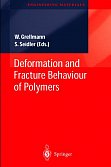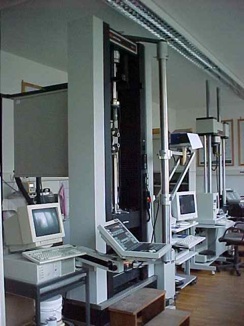Deformation and Fracture Behaviour of Polymers

Main Topics
- Characterization of Toughness by Means of Fracture Mechancis Methods (Newer Developments, Experimental Methods and Approximative Methods)
- Morphology-Property-Correlations (Polymers, Blends and Copolymers)
- Hybrid Methods of Polymer Testing and Diagnostics
- Technological Test Methods
- Biocompatible Materials and Medical Prostheses
- Special Materials
- Examples and Limits of Application
Contents/Inhaltsverzeichnis
contents_neu.pdf
(17 KB) vom 15.07.2013
Book Review
by Grigory Isaakovich Barenblatt:
In Applied Mechan. Rev. Vol. 56 No. 1 (2003) B5-B6
(Reviev als pdf-Datei)
review.pdf
(45,1 KB) vom 15.07.2013
"The book under review is composed of lectures presented at the Merseburg Discussion Conference with several additional contributions which the editors considered of special importance to the book´s integrity. The majority of participants were from Germany and Austria.
To explain the idea of the book as the present reviewer sees it, let us imagine for a moment that structural materials are ideal quasi-brittle bodies. The material constants: Young´s modulus, Poissons´s ratio, and fracture toughness (cohesion modulus) can be determinded rather easily by experiment using solutions to certain special problems. In this imaginary situation, all problems of structural design would be reduced to computing the solutions of well-defined, generally speaking, nonlinear problems of elasticity theory. (The problems are nonlinear free-boundary problems due to the specific conditions at the unknown beforehand crack contours.) These problems present, of course, some computational difficulties, but in principle there is no significant difficulty in their solution.
The present book shows that such an idyllic picture is very far from reality even for such pleasant (for the illustration of the basic ideas of fracture mechanics) materials as polymers. Nevertheless, the intention of the editors and authors is to show to practical engineers who use polymeric materials in their work that fracture mechanics even in its modern state (with certain hélas incomplete corrections for overall plasticity) can be a useful framework for guidance. The authors had no such intention, but the book could be also useful for theoreticians working in fracture mechanics showing them real problems arising, with necessary modifications of the basic models.
A remarkable property of the book is also that it shows, sometimes implicitly, how incomplete is our knowledge of fracture even for most favorable materials, and so emphasizes the directions of further investigations. Also very important is that the book presents problems arising in real testing of real polymeric materials widely used in industry following existing standards, in particular of the European Structural Integrity Society (ESIS). The basic weakness of today´s testing procedures, which the authors recognize and demonstrate very clearly, is: It is unclear what universal properties of materials can be “extracted” and learned from these tests and then used in quantitative design of real structures.
There are several examples: the very instructive paper by Ramsteiner et al, “Concepts of fracture mechanics for polymers.” Section 4: Nonlinear fracture mechanics. The authors propose a self-similar relation J = C1 (Delta a)^C2 instead of two straight lines. First of all, this reviewer does not think that this relation is “more realistic” as the authors claim: there are definitely two phases of the crack extension-blunting and stable crack propagation, and the process is definitely not self-similar as it would be dietated by the power law. Furthermore, what are the “fitting parameters” C1 and C2? It is clear that they are not universal. What to do with them in this case? That is, how does one use them?
In the previous section, page 31, discusses the fatigue test (Fig. A18): a rather long rectilinear part of the dependence of logarithm of cyclic stress intensity factor, similar to the Paris-Erdogan power law. Again the same question: Are the coefficients of this power law universal, or do they depend on the specimen size? The answer is of crucial importance because these coefficients determine the lifetime of the structure!
The same question can be asked about the relation (F3) in the very interesting paper by W. Grellmann, his colleagues, and B. Michel: da/dN = C(Delta T)^ß. The authors claim that ß is a “material-specific exponent.” Are they sure that these parameters will be the same for specimens of a different size? If not, how does one determine the lifetime? Reading this book presents many such challenges, and it is very good.
The list of problems considered in the book is impressive, although this reviewer would be interested to see some fresh ideas concerning the neck propagation, in particular in nylon, and also unsteady and thermal vibrocreep, both phenomena characteristic of polymers. Therefore, the present book is definitely a reference book. This reviewer sees two different audiences to which the book will be of interest – practical engineers designing and researching structures using polymeric materials, and theoreticians working in fracture mechanics. Both will find in this book many challenging problems. The quality of publication is good, especially the quality of the figures; the publication corresponds to the standards of good old Springer. Deformation and Fracture Behavior of Polymers is recommended to all large technical libraries."




